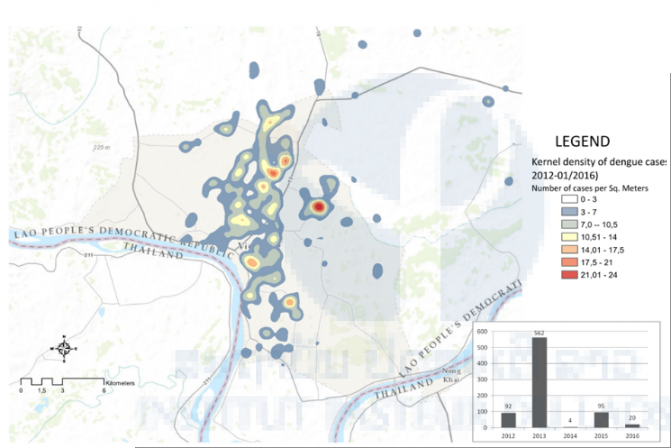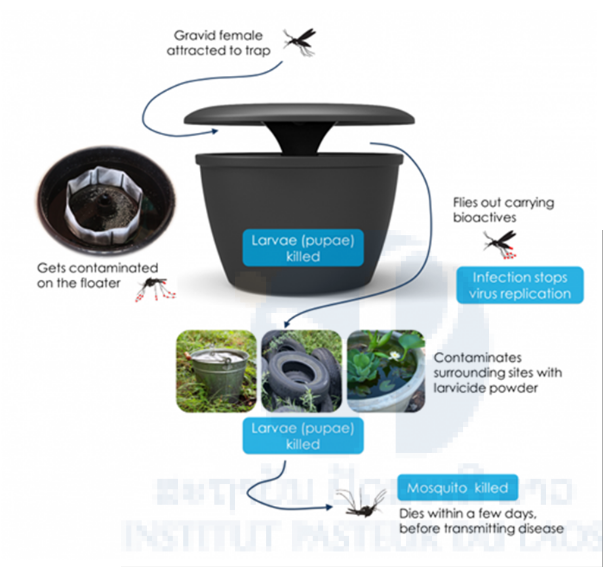Economic development, ecosystem modifications, and emerging infectious diseases risk evaluation (ECOMORE II). Entomology work package.

Supervisors:
Dr. Sebastien Marcombe (IPL) Dr. Paul Brey (IPL)
Entomology field collection, identification, and insecticide resistance monitoring:
Dr. Sebastien Marcombe (IPL) Dr. Phoutmany Thammavong (IPL) Khaithong Lakeomany (IPL)
Nothasin Phommavan (IPL)
Phonesavanh Luangamath
Somphat Nilaxay
Finance and administration:
Dr. Antoine des Graviers Phouvanhnamalee Vilaysouk
Description of the entomological work package
The ECOMORE II project has just started and will continue until 2019
Mosquito surveillance, insecticide resistance, and innovative vector control method
Mosquito surveillance
The recent economic development of Laos, characterized by one of the highest rates of urbanization in the ASEAN community and the development of outer-urban zones where the density of population is combined with rural activities, offers ideal ecosystems for the proliferation of Aedes mosquitoes, specifically in Vientiane. An epidemiological study carried out in Vientiane since 2012 has shown the existence of dengue transmission hotspots in several areas of the city . It is important to know the dynamics of the mosquito populations during the dry and rainy seasons in these various localities. Indeed, it is crucial to understand the geography of Aedes mosquitoes regarding their environment in order to understand if risk factors are related to the Aedes index or—as suggested by other researches—to other factors. To do so, mosquito larval measurement (Breteau index and container index) will be carried out in different types of areas (created by GIS). The result of the surveillance will allow us to identify times and locations where mosquito control would have the maximum impact on disease diffusion in the city (in central or rural spaces, during transmission or low transmission season, etc.). If other mosquito species are present during the Aedes surveillance, they will be collected and screened for arboviruses.

Figure 1: Kernel density of dengue cases in Vientiane, Laos (2012–01/2016).
Insecticide resistance
During inter-epidemic periods or when the elimination of mosquito breeding habitats is not easily achievable, insecticide application in larval habitats is routinely conducted by public health services in many countries, including the Lao PDR (Rawlins 1998, Rodriguez et al., 2002, Thavara et al., 2004). Space-spraying applications are conducted during epidemics or when the entomological indices of mosquitoes are high. For both larviciding and adulticiding, organophosphates and pyrethroids are the insecticide families of choice, worldwide and in the Lao PDR. Unfortunately, many dengue vector control programs are threatened by the development of insecticide resistance in Aedes populations across the world (Marcombe et al. 2009). Strong levels of resistance to organophosphates and pyrethroids have been detected in Aedes aegypti populations in Southeast Asia (Marcombe et al., 2009, 2014 ; Jirakanjanakit et al., 2007; Ranson, 2010; Kamgang et al., 2010 ; Vontas et al., 2012). The organophosphate temephos (larvicide) and insecticides from the pyrethroid family (permethrin, deltamethrin; adulticides) have been used in the Lao PDR for decades and specifically during the last outbreak in 2013. Compared to its neighboring countries (Vietnam and Thailand), there was no information available on the resistance status of Aedes populations and the possible impact of the resistance on vector control operations in the country.
A preliminary study led in 2015 by the Institut Pasteur du Laos showed insecticide resistance in Aedes populations from several provinces as well as in Vientiane (Marcombe et al. in prep). In view of these results, it is important now to know more precisely the distribution and resistance levels of the populations of vectors in Vientiane in order to propose alternative strategies. Resistance to conventional insecticides (temephos, deltamethrin, permethrin, and malathion) will be tested on Aedes aegypti and Ae. albopictus larvae and adults collected in Vientiane. Distribution maps of the resistance by species and at larval/adult stages will be drawn up and shared with stakeholders to improve the efficiency of the vector control campaign.
Innovative vector control method
In recent years, a number of new tools to combat vectors have been developed and present an interesting potential to replace or strengthen the current expensive and laborious methods of larvicide treatments and fumigation. Furthermore, the actual efficiency of these methods is often discussed (Marcombe et al. 2012). Among these tools, the method described as “auto-dissemination” presents an innovative technique for the treatment of breeding sites. It consists of using female mosquitoes themselves as carriers of an insecticide, the pyriproxyfen (insect growth regulator), and to make them transfer the insecticide to the larval breeding sites in urban areas. The potential of this technique and this insecticide was proved in small-scale trials in Peru, Italy, and Madeira (Guess et al., 2009; Caputo et al., 2012) and is in development on other sites. We suggest in this project studying the efficacy of this method to control vectors in the specific urban environment of the city of Vientiane.

In2Care® mosquito trap.
Objectives
+ Define the dynamics of vectors
+ Organize an active entomological surveillance in representative districts to document the annual dynamics of the populations of vectors
+ Set up a systematic entomological balance sheet of the housing environment of the confirmed cases and possibly the other possible sites of contamination to identify active zones of transmission
+ Measure the levels of insecticide resistance of the Aedes populations against conventional insecticides used in Vientiane to recommend the appropriate methods of vector control to the authorities
+ Estimate innovative strategies of vector control by measuring their efficacy on the populations of mosquitoes to propose alternatives to the conventional methods
+ Investigate the possibility of alternative vectors.
Financial support
This work is supported by the Agence Française de Développement.







